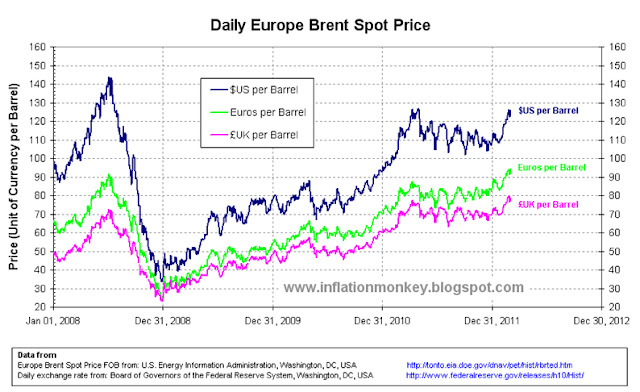Copper Price Today is as Expensive as it was in the 1970s Once Accounting for Inflation
Copper in a common metal which as been used since ancient times. Due to its very good electrical and thermal conductivity it used in a very wide range of industrial applications from wires cables to sea water corrosion resistant bronzes used to make marine propellers. Because of this it is often refereed to as one if the bellwether industrial commodities, which are used to trend the health of global industrial production.
Over the last couple of years, I have repeatedly come across comments that copper has never been this expensive and that this will push up the price of consumer goods or cause industrial production to slow or contract. There are some reviews of the copper market and price such
as the following:
"What to do as Dr Copper turns bearish"
"The Copper Yuan Carry Trade"
"Copper and Global Stock Markets Rollover"
"Copper Price Forecast, The Fall of The ChineseMiracle 2012"
However these don’t usually cover the long term price history or adjusted to account for inflation, so I thought that I would investigate.
The annual average copper price data since 1900 to2010 came from the USGeological Survey. The data for 2011 and the early part of 2012 came from the World Bank. In both cases the price data is based on the average price of Grade A cooper traded on the London Metals Exchange (LME). The historical UK Pound to US Dollar exchange rate data came from Lawrence H. Officer, "Dollar-Pound Exchange Rate From1791", MeasuringWorth, 2011 at www.measuringworth.com/exchangepound/. The prices were adjusted for inflation by converting the nominal price into the equivalent in 2011 US Dollars and 2011 GP Pounds Stirling. The US inflation data came from the historical CPI from the US Department of Labor.
For the UK inflation the data came from Dominic Webb (2006) "Inflation:the Value of the Pound 1750-2005" Economic Policy and Statistics Section, Research Paper 06/09, House of Commons Library, UK. From this you get the following results shown in the graph below.
 |
Historical Annual Average and Inflation Adjusted
Copper Price since 1900 in US Dollars and UK Pounds |
The doted lines are the unadjusted nominal annual average copper price, and the sold lines are the inflation adjusted copper price. The first thing that becomes obvious is that the unadjusted copper price was at its lowest in the in 1932 in both US Dollars and Pounds Sterling at approximately $128 and £36 per a metric tonne respectively. Additionally before 2012 the nominal price peak occurred in 2011 in both US Dollars and UK Pounds at $8,823 and £51504 per a metric tonne respectively.
However when you examine the inflation adjusted copper price, you notice that its lowest prices occurred in 2002 in US Dollars at $2,089 and in 1999 in UK Pounds at $1,465 per metric tonne. The closed the inflation adjusted price came to those lows in both currencies, occurred in 1932, 1945, and 1993. The highest inflation adjusted price happened in 1916 in US Dollars and Pounds Sterling at $12,962 and £9,383 respectively.
The historic inflation adjusted copper prices in US Dollars and UK Pounds can be more easily seen in the chart below which only shows the inflation adjusted price on a linear axis (non logarithmic, unlike the first chart).
 |
Inflation Adjusted Copper Price since 1900 in US
Dollars and Pounds Sterling |
As it came bee seen the general trend in the inflation adjusted copper prices was a high volatility before the 1920s, were upon it experienced a sharp decrees by the early 1920s. Prices were relatively stable from the 1920s until the end of the 1940s, in competition to the price volatility see before the 1920s. During the 1950s there was a sharp rise to $7,662 and £6,775 in US Dollars and GB Pounds respective. The price dropped almost 50% by 1958 in both currencies, where upon it steadily increased to peak in 1970 and 1974 at a price similar to that in 1955.
From the peak in 1974 the price steadily decreased to an all time inflation adjusted low by 2002 in US Dollars at $2,089 per metric tonne. In UK Pounds the all time inflation adjusted low occurred in 1999 at $1,465 per metric tonne and this was almost matched again in 2003 at £1,483. Since these lows the inflation adjusted copper price was increases rapidly to prices comparable to those seen in the 1970s.
Using the price in 1900 as a baseline the inflation adjusted copper price in UK Pounds and US Dollars was indexed. This allows the examination of the relative price changes during this historical period of time more easily and is shown below.
 |
Historical Inflation Adjusted Copper Price since
1900 in US Dollars and GB Pounds, Indexed to 1900 |
The indexed price data clearly displays that the historic inflation adjusted copper price has drop since the 1900s but not by any ware as much as the inflation adjusted aluminium price had done. By the early 2000s the copper price bottomed at almost 20% of the price of what it was in 1900. This was slightly lower than the previous bottom in 1930. The current copper price by the beginning of 2012 is comparable to the inflation adjusted prices in the 1970s, which were slightly lower than the average in the years before the 1920s.
So from a historical perspective once inflation has been accounted for the price of copper is comparable to the peaks seen in the 1970s. This begs the question, as copper is used as a bellwether the health of global industrial production, does this means the developed economies are due to repeat the economic difficulties that were experienced in the 1970s?
Written by Inflation Monkey. Join on Google+














